...
| Numbered figure captions |
|---|
| SubtitleText | Select the PCA task from the Exploratory analysis menu |
|---|
| AnchorName | Select PCA task |
|---|
|
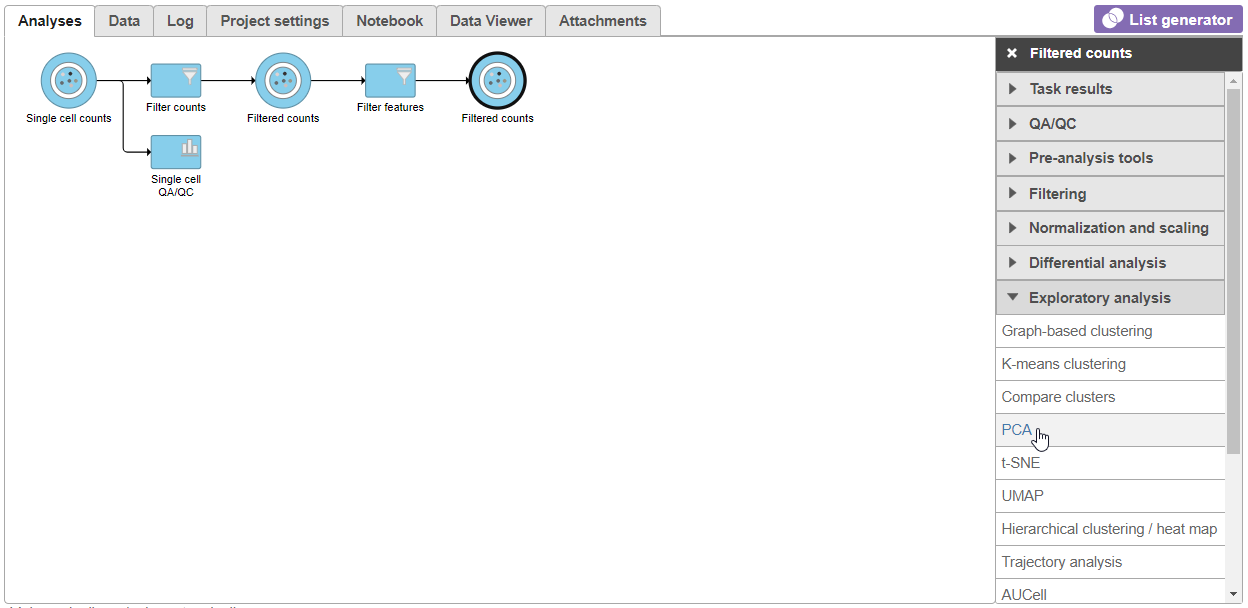 Image Modified Image Modified
|
- Click Finish to run PCA with default settings (Figure 2)
...
| Numbered figure captions |
|---|
| SubtitleText | PCA task set up page with default settings |
|---|
| AnchorName | PCA task set up |
|---|
|
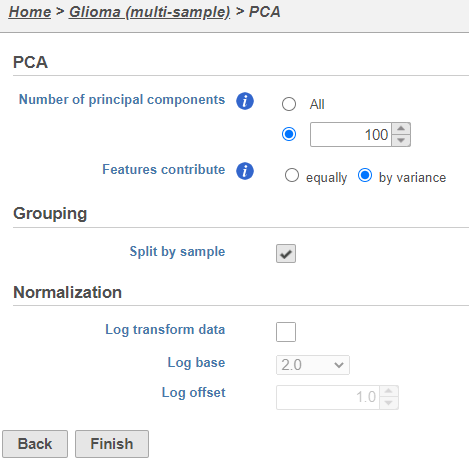 Image Removed Image Removed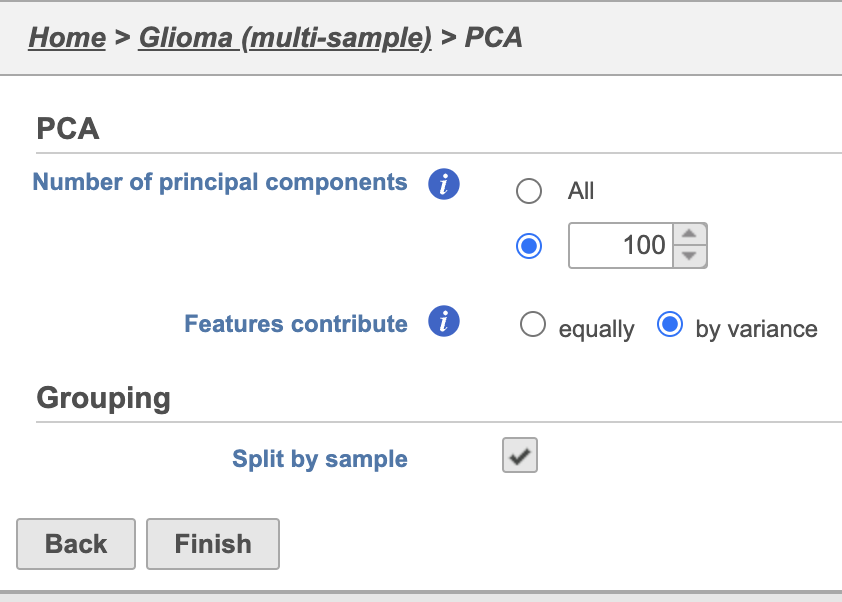 Image Added Image Added
|
PCA task and data nodes will be generated.
...
| Numbered figure captions |
|---|
| SubtitleText | Invoking t-SNE from the task menu |
|---|
| AnchorName | Invoking t-SNE |
|---|
|
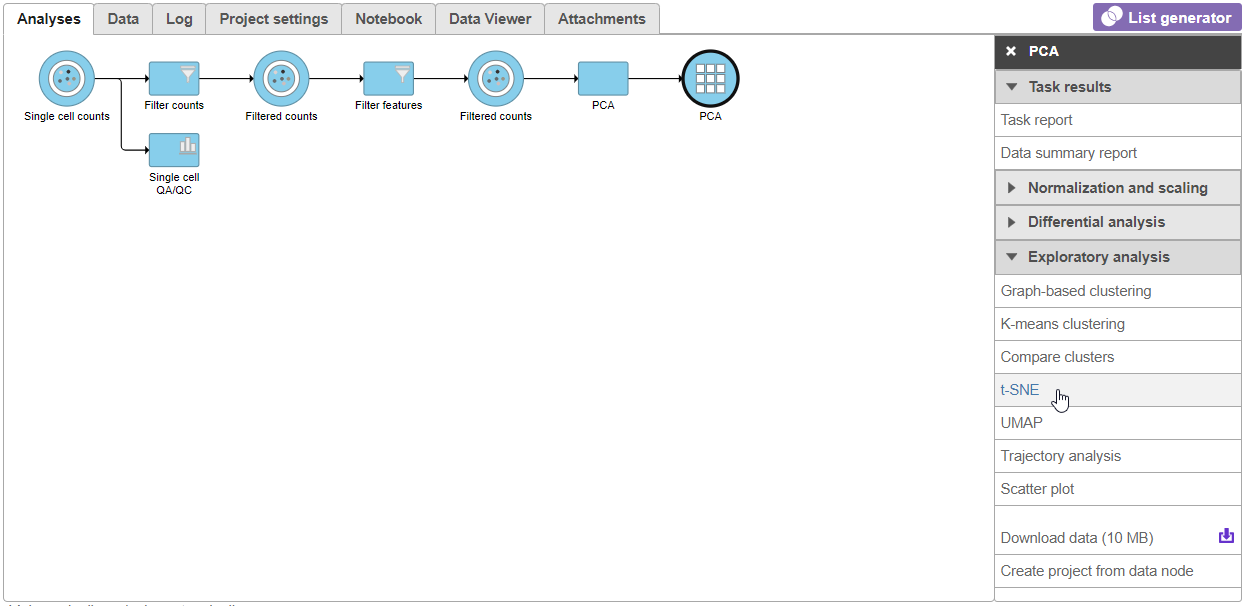 Image Modified Image Modified
|
- Click Finish from the t-SNE dialog to run t-SNE with the default settings (Figure 4)
...
| Numbered figure captions |
|---|
| SubtitleText | t-SNE task set up with default settings |
|---|
| AnchorName | t-SNE task set up |
|---|
|
 Image Removed Image Removed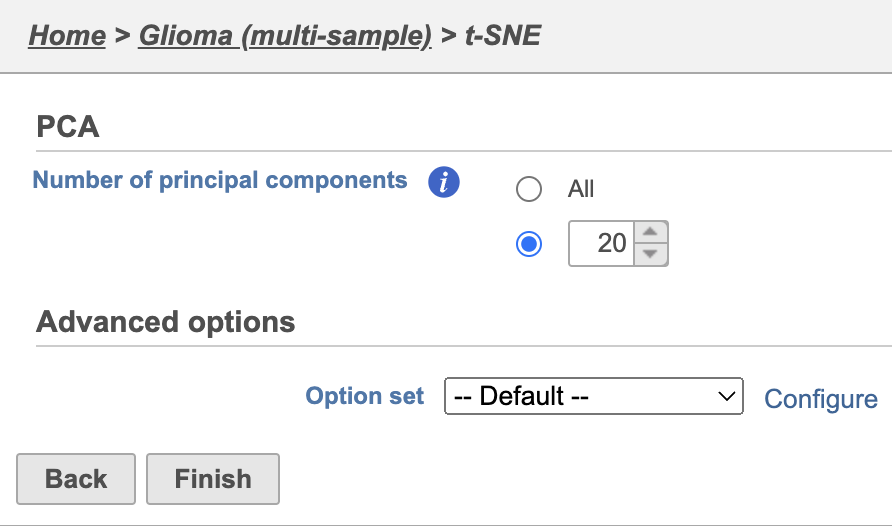 Image Added Image Added
|
Because the upstream PCA task was performed separately for each sample, the t-SNE task will also be performed separately for each sample. t-SNE task and data nodes will be generated (Figure 5).
...
| Numbered figure captions |
|---|
| SubtitleText | t-SNE task node |
|---|
| AnchorName | t-SNE task node |
|---|
|
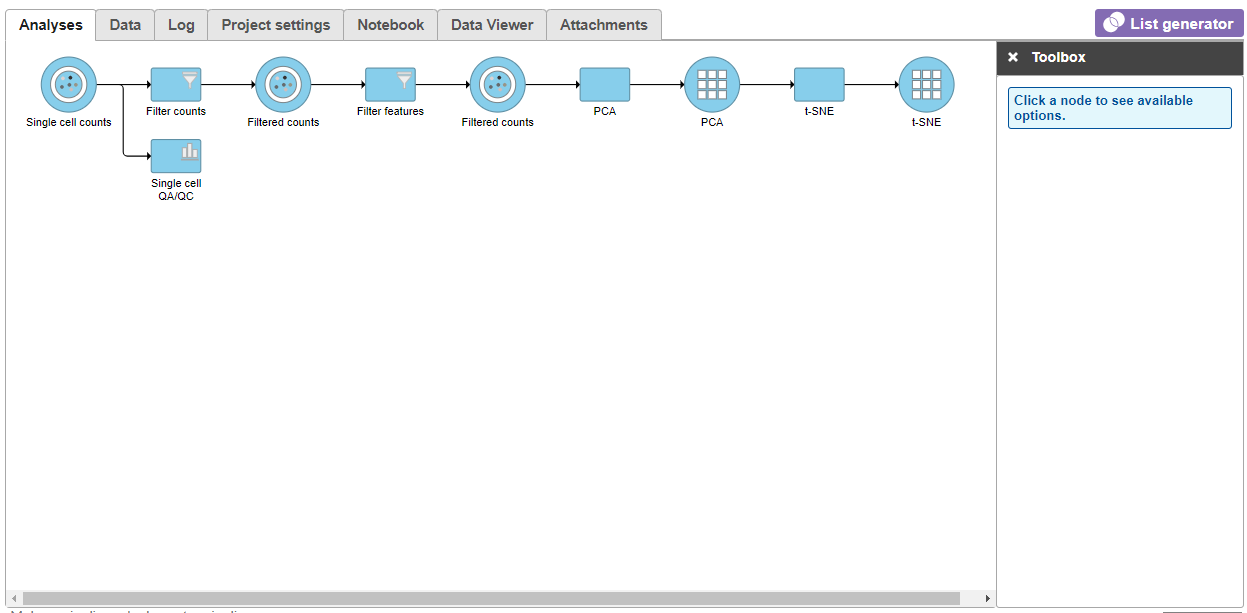 Image Modified Image Modified
|
Once the t-SNE task has completed, we can view the t-SNE plots
...
| Numbered figure captions |
|---|
| SubtitleText | Viewing t-SNE plot of a single sample |
|---|
| AnchorName | Viewing single-sample t-SNE |
|---|
|
 Image Removed Image Removed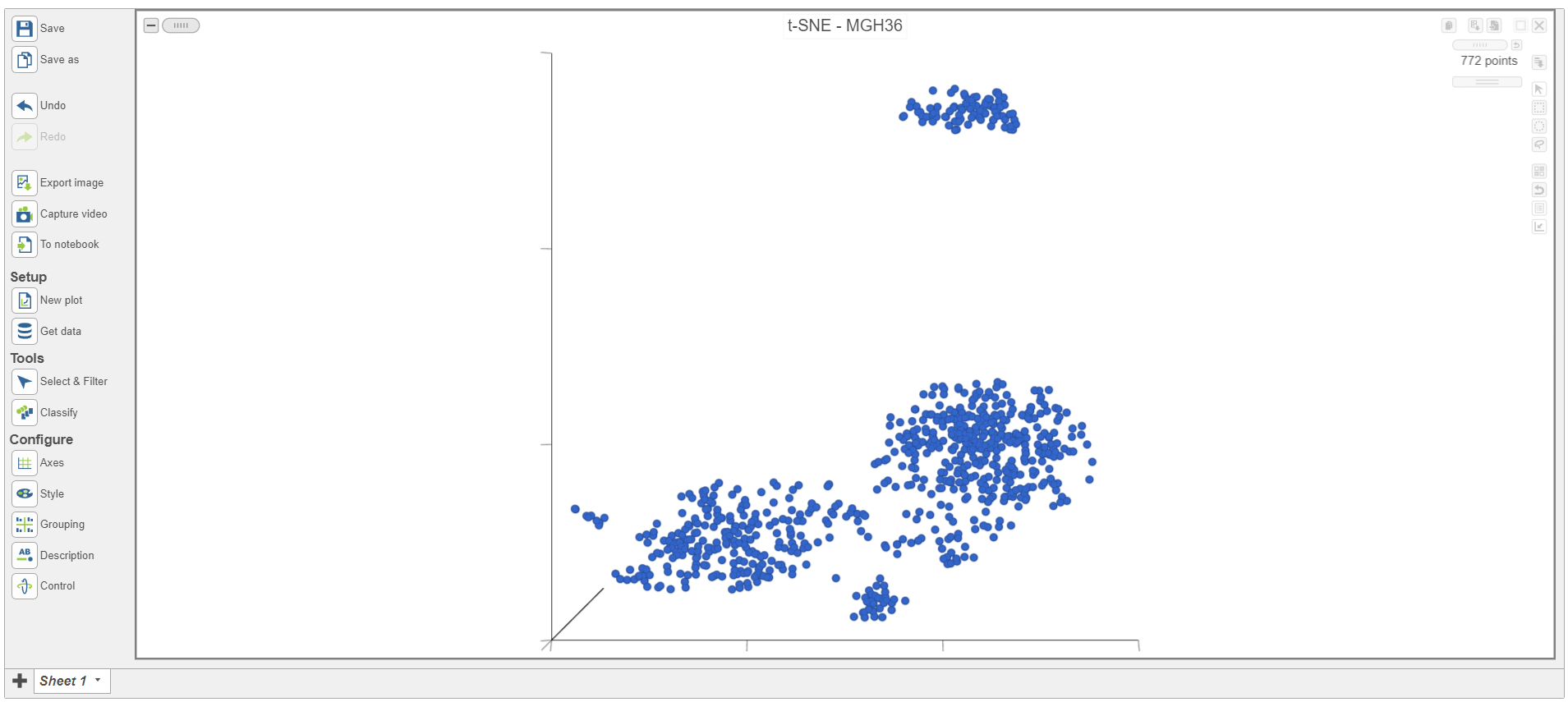 Image Added Image Added
|
The t-SNE plot is in 3D by default. To change the default, click your avatar in the top right > Settings > My Preferences and edit your graphics preferences and change the default scatter plot format from 3D to 2D.
...
Each sample has its own plot. We can switch between samples.
- Scroll down on the Configuration card on the left and expand the Data card Open the Axes icon on the left under Configure (Figure 7)
- Navigate to Misc
- Select the
 icon below the sample Sample name to go to the next sample
icon below the sample Sample name to go to the next sample
...
| Numbered figure captions |
|---|
| SubtitleText | Viewing t-SNE plot of MGH42 |
|---|
| AnchorName | Viewing single-sample t-SNE (2) |
|---|
|
 Image Removed Image Removed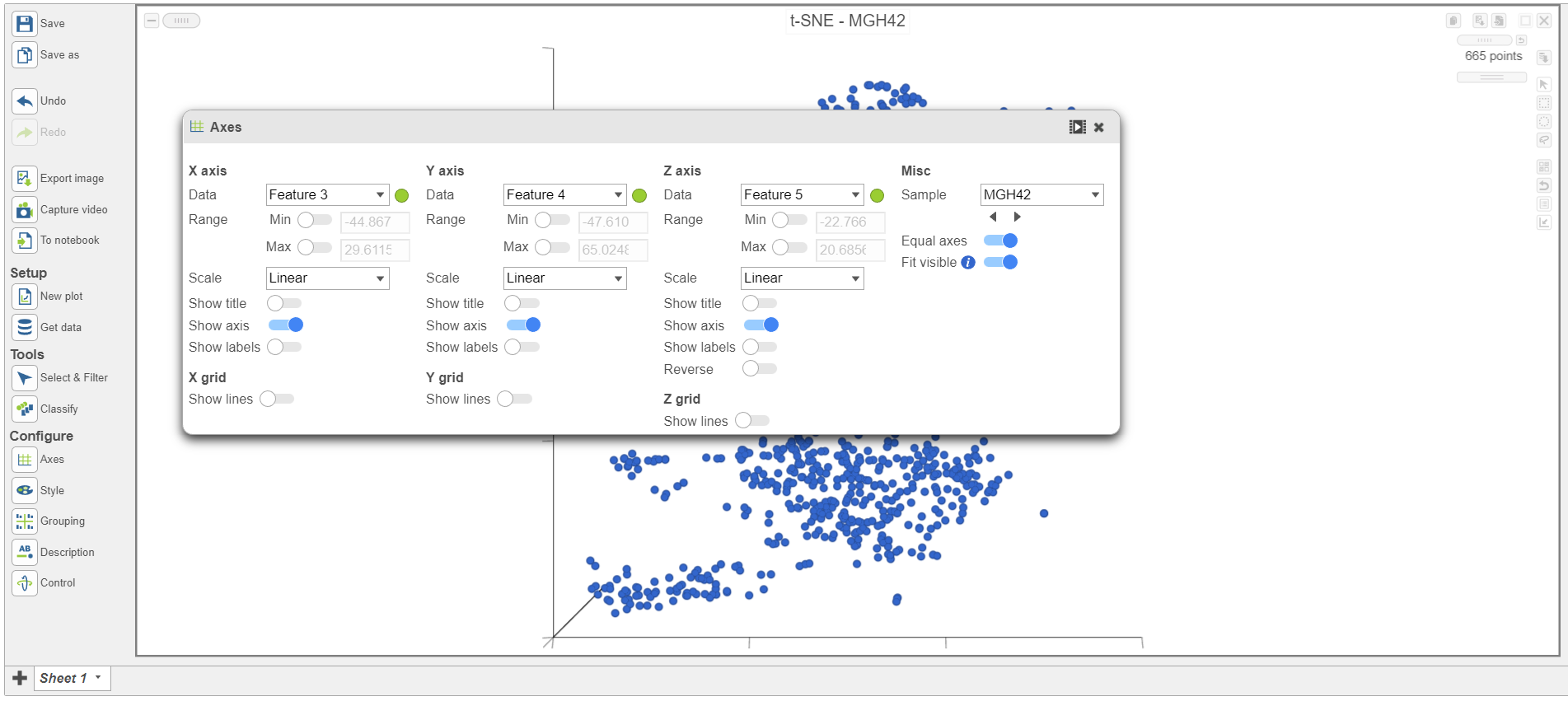 Image Added Image Added
|
The goal of this analysis is to compare malignant cells from two different glioma subtypes, astrocytoma and oligodendroglioma. To do this, we need to identify the malignant cells we want to include and which cells are the normal cells we want to exclude.
...
- Select any of the count data nodes from the Data card on Get data on the left (Single cell counts, or any of the Filtered counts, Figure 8)
- Search for the BCAN gene
- Click and drag the BCAN gene onto the plot and drop it over the Green (feature) option
...
| Numbered figure captions |
|---|
| SubtitleText | Coloring cells by BCAN expression |
|---|
| AnchorName | Selecting gene |
|---|
|
 Image Removed Image Removed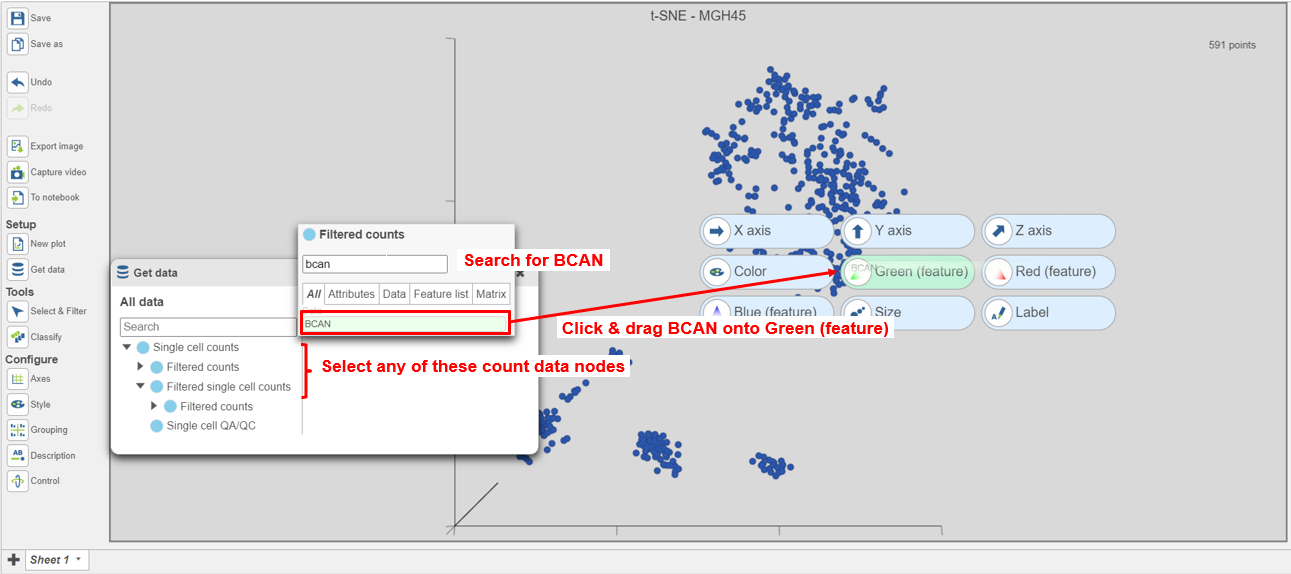 Image Added Image Added
|
The cells will be colored from black to green based on their expression level of BCAN, with cells expressing higher levels more green (Figure 9). BCAN is highly expressed in glioma cells.
...
| Numbered figure captions |
|---|
| SubtitleText | Viewing expression levels for a group of cells |
|---|
| AnchorName | Viewing expression levels for a group of cells |
|---|
|
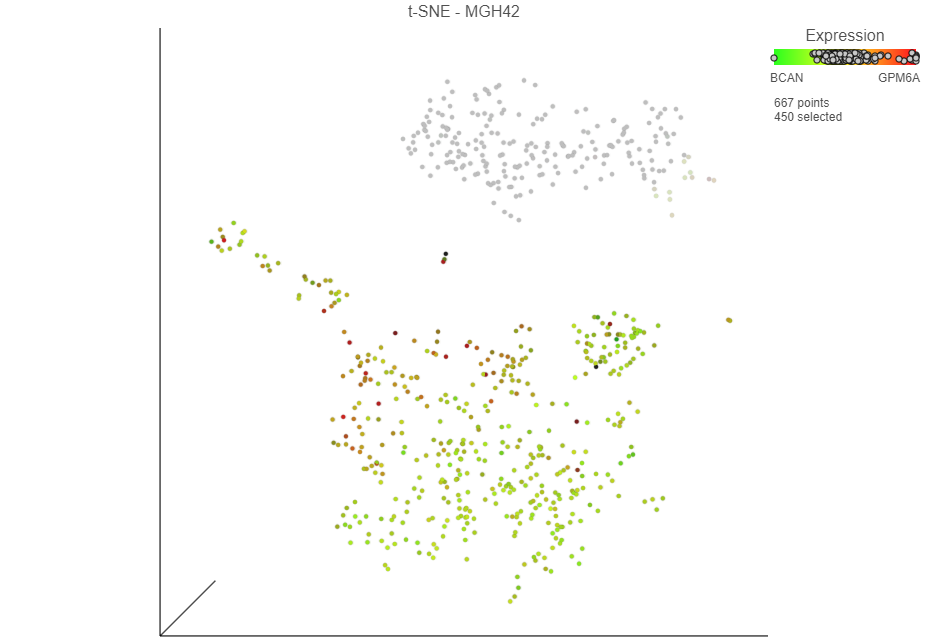
|
- Click Classify selection in the Classification card on the right in the Classify icon under Tools
A dialog to give the classification a name will appear.
...
| Numbered figure captions |
|---|
| SubtitleText | Classifying selection |
|---|
| AnchorName | Classifying cells |
|---|
|
 Image Removed Image Removed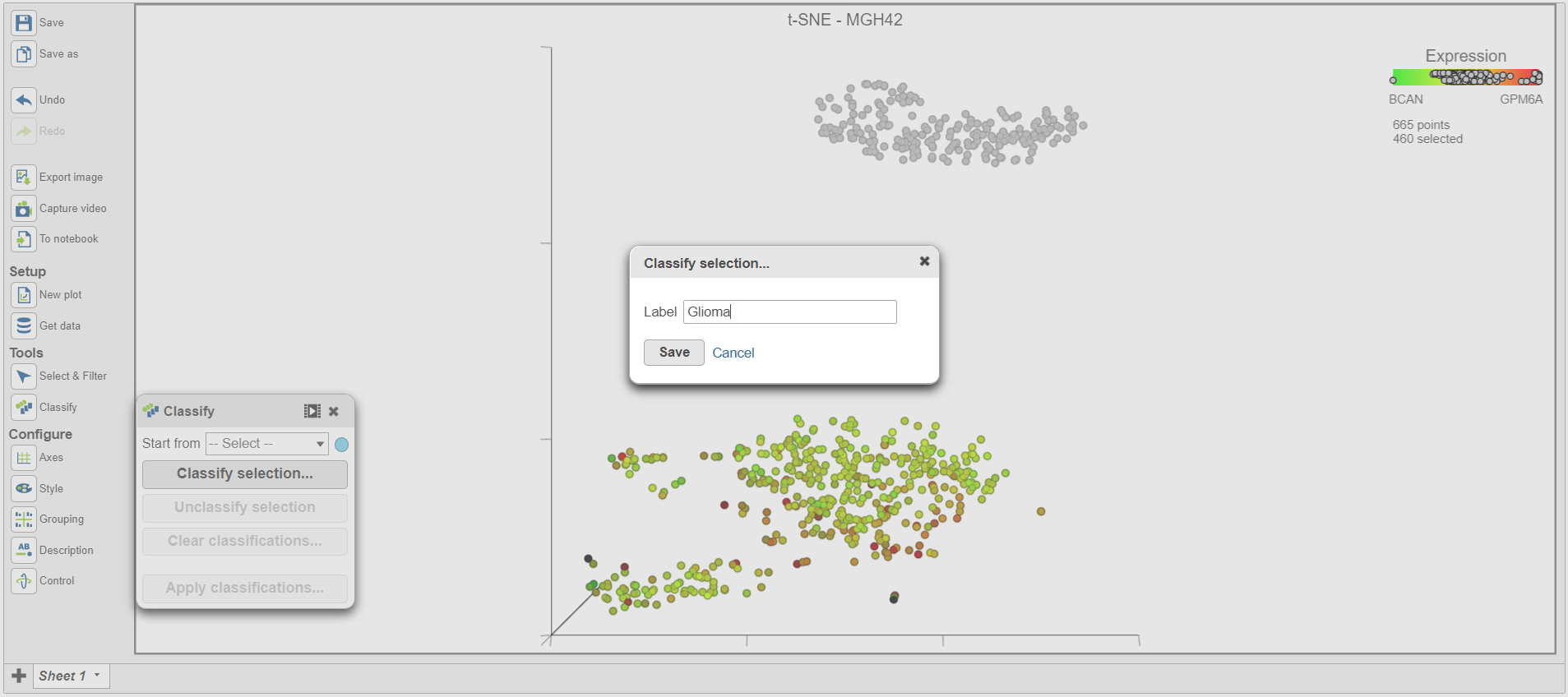 Image Added Image Added
|
Once cells have been classified, the classification is added to the Classifications card on the right Classify. The number of cells belonging to the classification is listed. In MGH42, there are 450 460 glioma cells (Figure 15).
...
| Numbered figure captions |
|---|
| SubtitleText | The number of cells in each classification is displayed in the Classification card on the right. |
|---|
| AnchorName | Viewing classifications |
|---|
|
 Image Removed Image Removed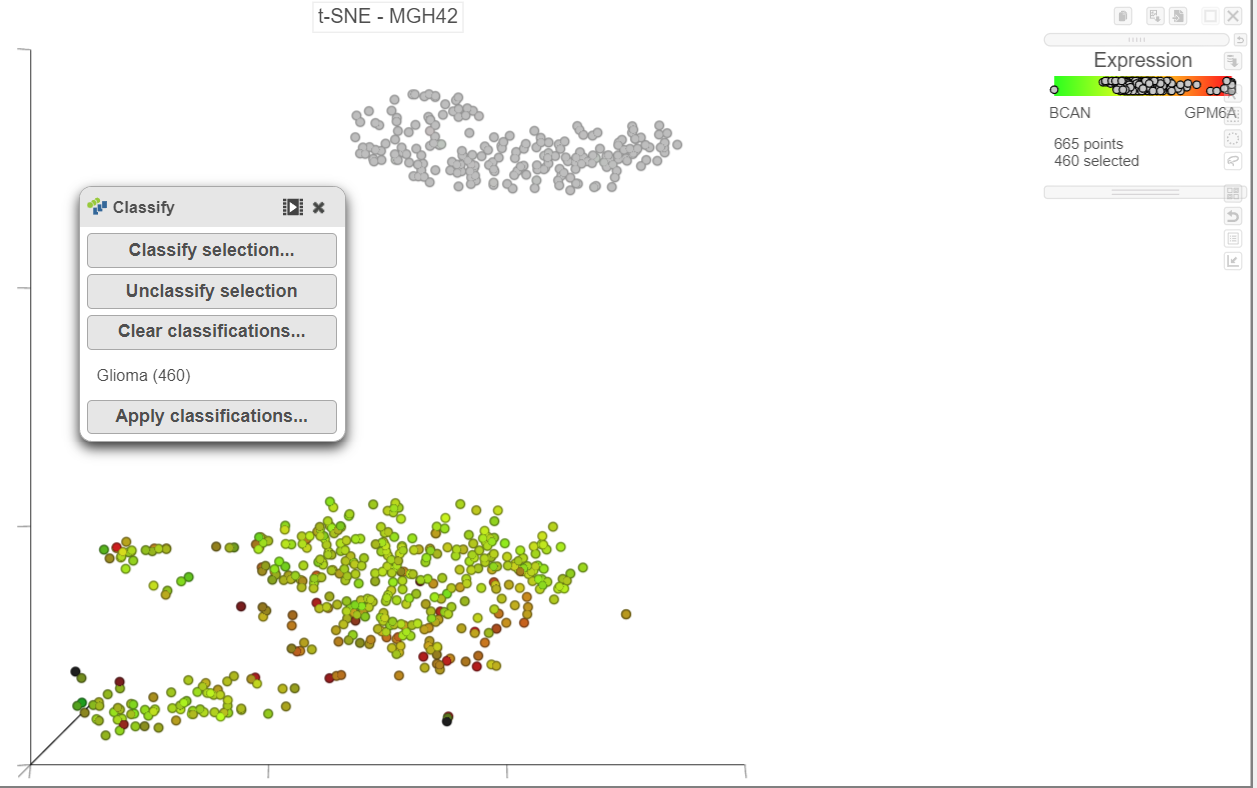 Image Added Image Added
|
Classifications made on the t-SNE plot are retained as a draft as part of the data viewer session. In this tutorial, we will classify malignant cells for each sample before we save and apply the classifications, but if necessary, you can save the data viewer session by clicking the  Image Removed save
Image Removed save  Image Added Save icon on the left to retain all of the formatting and draft classifications. The data viewer session will be stored under the Data viewer tab and can be re-opened to continue making classifications at a later time.
Image Added Save icon on the left to retain all of the formatting and draft classifications. The data viewer session will be stored under the Data viewer tab and can be re-opened to continue making classifications at a later time.
- Switch to pointer mode by clicking
 in the top right corner of the plot
in the top right corner of the plot - Deselect the cells by clicking on any blank space on the plotScroll down on the Configuration card on the left and expand the Data card
- Open Axes and navigate to Sample under Misc
- Select the
 icon below the sample name to go to the next sample, MGH45
icon below the sample name to go to the next sample, MGH45 - Rotate the 3D t-SNE plot to get a better view of cells from the green, red, and yellow cluster
- Switch to lasso mode by selecting
 in the top right corner of the plot
in the top right corner of the plot - Draw the lasso around the cluster of colored cells and click the circle to close the lasso (Figure 16)
...
| Numbered figure captions |
|---|
| SubtitleText | Classifying malignant cells in sample MGH45 |
|---|
| AnchorName | Classifying cells |
|---|
|
 Image Removed Image Removed Image Added Image Added
|
- Select Classify selection in the Selection card on the rightthe Classify icon
- Type Glioma or select Glioma from the drop-down list (Figure 17)
- Click Save
...
| Numbered figure captions |
|---|
| SubtitleText | Adding cells in a second sample to an existing classification |
|---|
| AnchorName | Classifying cells as an existing classification |
|---|
|
 Image Removed Image Removed Image Added Image Added
|
- Repeat these steps for each of the 6 remaining samples. Remember to go back to the first sample (MGH36) to classify the glioma cells in that samples too.
There should be 5,348 322 glioma cells in total across all 8 samples.
- The classification name can be edited or deleted (Figure 18).
| Numbered figure captions |
|---|
| SubtitleText | Edit or delete the classification |
|---|
| AnchorName | Edit or delete the classification |
|---|
|
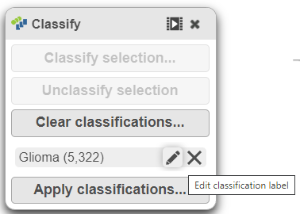 Image Added Image Added
|
With the malignant cells in every sample classified, it is time to save the classifications.
- Click Apply classifications in the Classification card on the right
- Click the Filtered counts data node as input data for the classification task (Figure 18)
- Click Select
| Numbered figure captions |
|---|
| SubtitleText | Choose the Filtered counts data node as input for the Classification task |
|---|
| AnchorName | Choose input data node for Classification task |
|---|
|
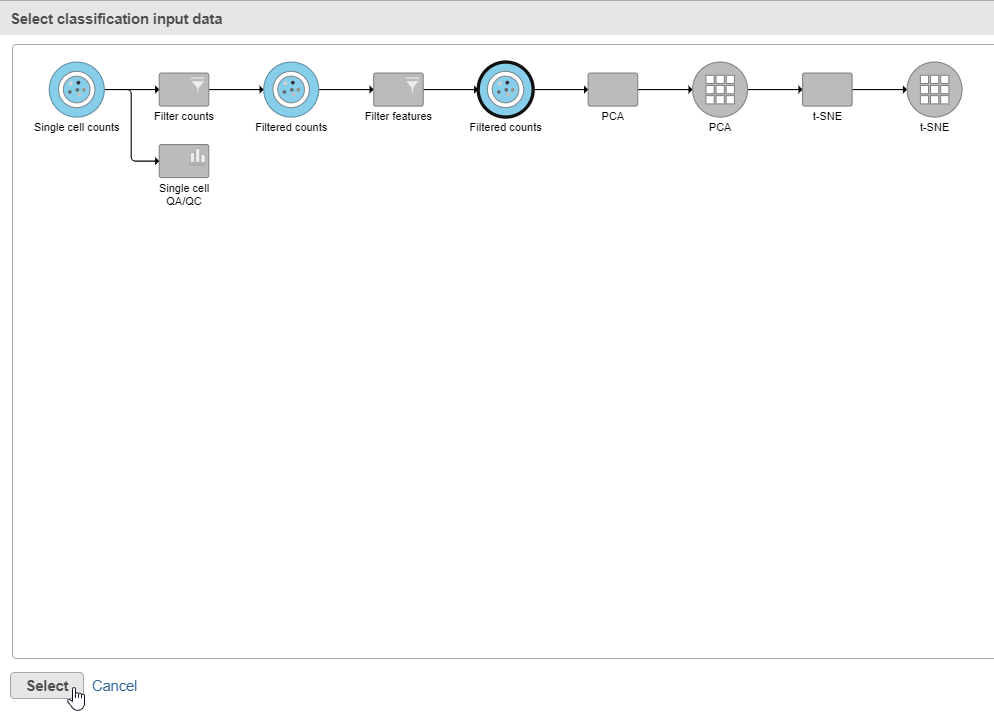 Image Removed Image Removed
|
- Classify icon
- Name the classification attribute Cell type (sample level)
- Click Run (Figure 19)
- Click Run
- Click OK on the information box that says a classification task has been enqueued
| Numbered figure captions |
|---|
| SubtitleText | Name the cell-level attribute |
|---|
| AnchorName | Classification Classifiy attribute name |
|---|
|
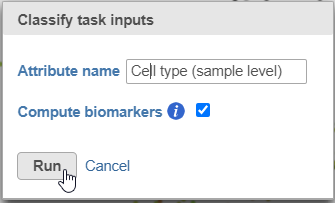 Image Removed Image Removed Image Added Image Added |
A new task, Classify, is added to the Analyses tab. This task produces a new Classify result data node (Figure 20).The new attribute is stored in the Data tab and is available to any node in the project.
- Click on the Glioma (multi-sample) project name at the top to go back to the Analyses tab
- Your browser may warn you that any unsaved changes to the data viewer session will be lost. Ignore this message and proceed to the Analyses tab
| Numbered figure captions |
|---|
| SubtitleText | The Classify cells tasks generates a Classified groups data node |
|---|
| AnchorName | Classify cells task |
|---|
|
 Image Removed Image Removed
|
- Double-click the new Classify result data node to open the task report (Figure 21)
The Classification summary table shows a breakdown of the number of glioma cells that were classified per sample. The cells that were not classified are labeled N/A.
The Top marker features per label table shows the top 10 upregulated genes in each cell type. In this case, the glioma cells are compared to the N/A cells using ANOVA and the genes are filtered for fold-change >1.5 and sorted by descending fold-change values. To obtain the full list of biomarker genes with p-values and fold-changes, click the Download link in the bottom right of the table.
| Numbered figure captions |
|---|
| SubtitleText | Classification task report |
|---|
| AnchorName | Classification task report |
|---|
|
 Image Removed Image Removed
|
One multi-sample t-SNE plot
...
| Numbered figure captions |
|---|
| SubtitleText | Combine all cells into one plot by unchecking the Split by sample box |
|---|
| AnchorName | Multi-sample PCA setting |
|---|
|
 Image Removed Image Removed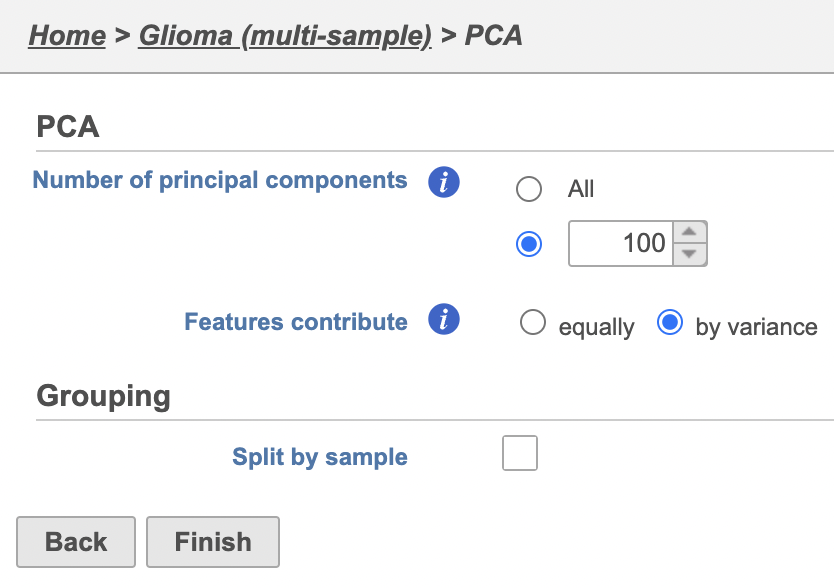 Image Added Image Added
|
The PCA task will run as a new green layer.
...
| Numbered figure captions |
|---|
| SubtitleText | Multi-sample PCA and t-SNE tasks are added as a new layer |
|---|
| AnchorName | PCA and t-SNE task new layer |
|---|
|
 Image Removed Image Removed Image Added Image Added
|
Once the task has completed, we can view the plot.
...
| Numbered figure captions |
|---|
| SubtitleText | Viewing the multi-sample t-SNE plot |
|---|
| AnchorName | multi-sample t-SNE plot |
|---|
|
 Image Removed Image Removed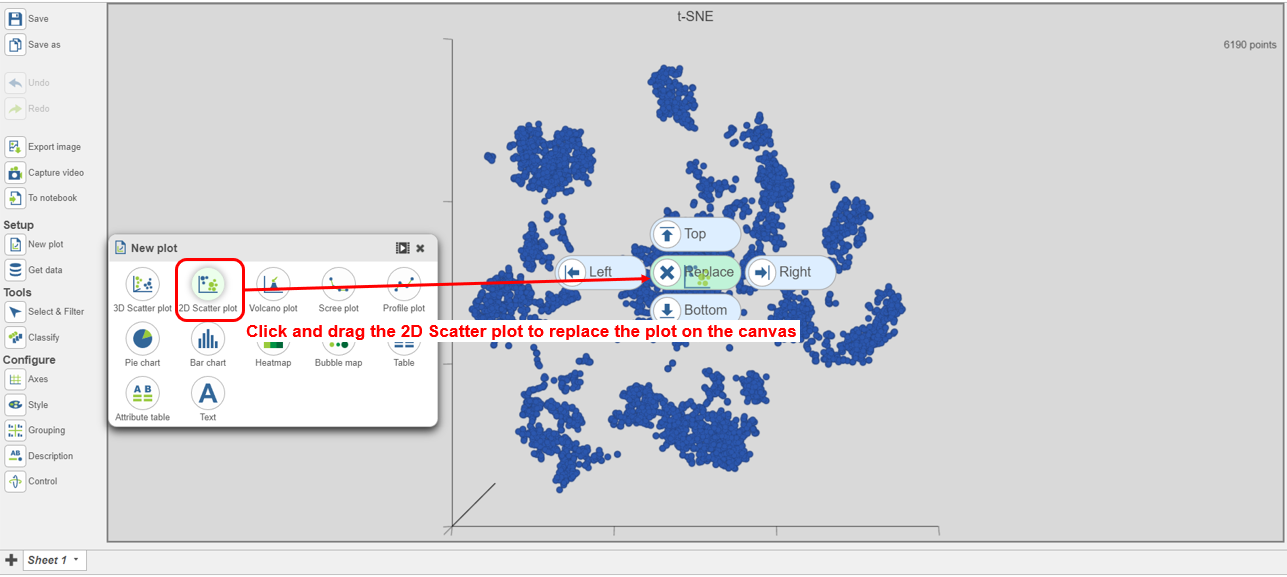 Image Added Image Added
|
- Search for and select green t-SNE data node (Figure 25)
...
| Numbered figure captions |
|---|
| SubtitleText | Select the green multi-sample t-SNE data node to draw the 2D t-SNE plot |
|---|
| AnchorName | Select multi-sample t-SNE data |
|---|
|

|
- In the Configuration card, expand the Color card and Style icon, choose Sample name from the Color by drop-down list under Color
Viewing the 2D t-SNE plot, while most cells cluster by sample, there are a few clusters with cells from multiple samples (Figure 26).
...
| Numbered figure captions |
|---|
| SubtitleText | Viewing the multi-sample t-SNE plot in 2D |
|---|
| AnchorName | Viewing 2D t-SNE |
|---|
|
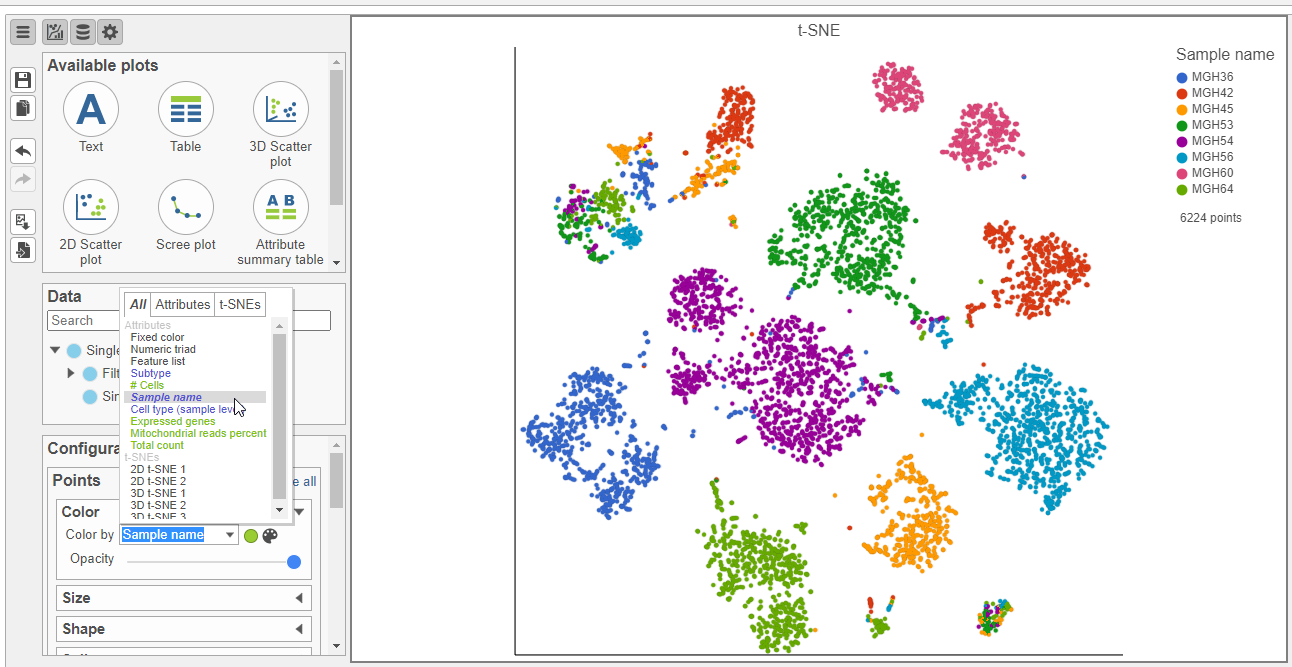 Image Removed Image Removed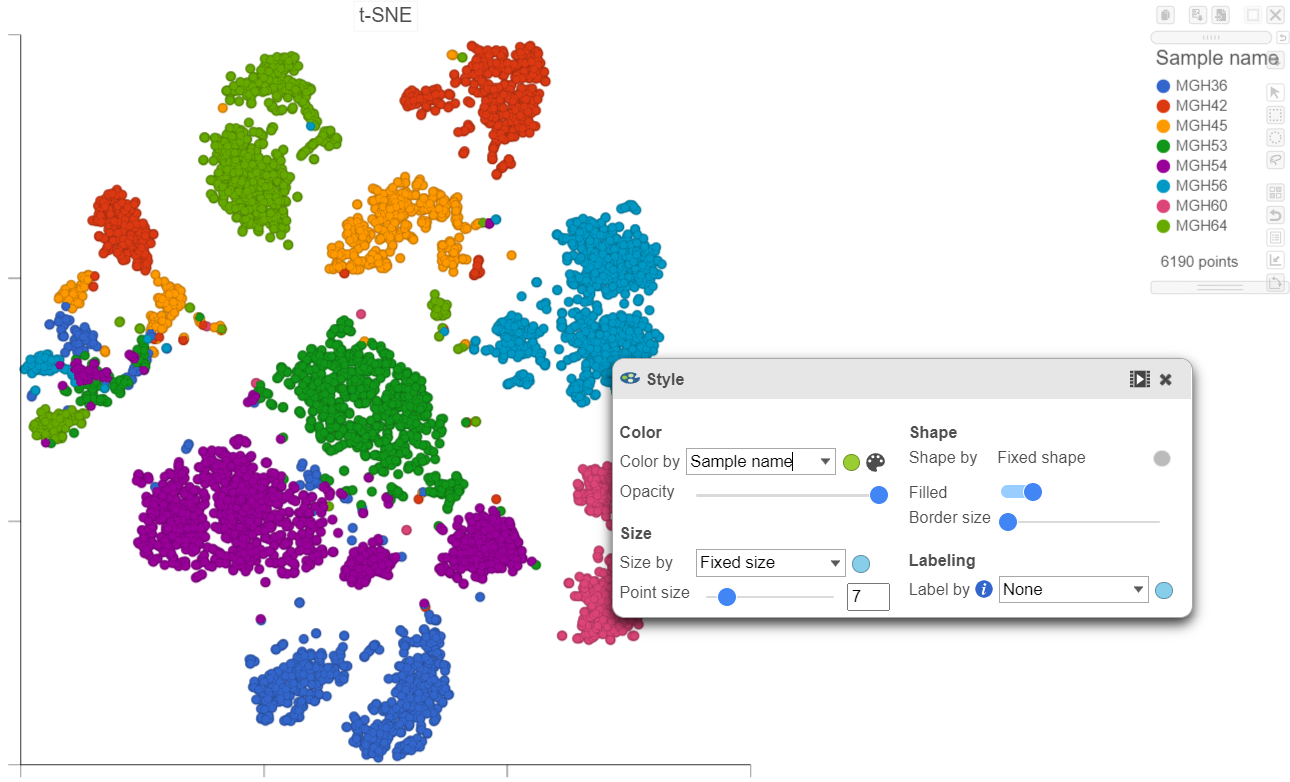 Image Added Image Added
|
Using marker genes, BCAN (glioma), CD14 (microglia), and MAG (oligodendrocytes), we can assess whether these multi-sample clusters belong to our known cell types.
...
- Switch to lasso mode by clicking the
 icon in the top right of the plot
icon in the top right of the plot - Draw the lasso around the cluster of red cells and click the circle to close the lasso (Figure 28)
- Click Classify Open the Classify tool and click Classify selection
- Name the classification Microglia
- Click Save
...
- Switch to pointer mode by clicking
 in the top right corner of the plot
in the top right corner of the plot - Deselect the cells by clicking on any blank space on the plot
- Switch to lasso mode again by clicking the
 icon in the top right of the plot
icon in the top right of the plot - Draw the lasso around the cluster of blue cells and click the circle to close the lasso
- Click Classify Open the Classify tool and click Classify selection
- Name the classification Oligodendrocytes
- Click Save
...
- Switch to pointer mode by clicking
 in the top right corner of the plot
in the top right corner of the plot - Deselect the cells by clicking on any blank space on the plot
- Switch to lasso mode again by clicking the
 icon in the top right of the plot
icon in the top right of the plot - Draw the lasso around the cluster of green cells and click the circle to close the lasso
- Click Classify Open the Classify tool and click Classify selection
- Name the classification Glioma
- Click Save
- Switch to pointer mode by clicking
 in the top right corner of the plot
in the top right corner of the plot - Deselect the cells by clicking on any blank space on the plot
The number of cells classified as microglia, oligodendrocytes, and glioma are shown in the Classification card on the right Classify (Figure 29)
| Numbered figure captions |
|---|
| SubtitleText | The number of cells for each cell type |
|---|
| AnchorName | Number of cells per type |
|---|
|
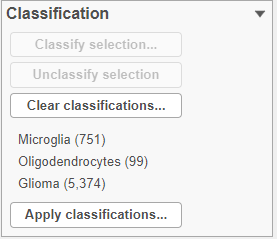 Image Removed Image Removed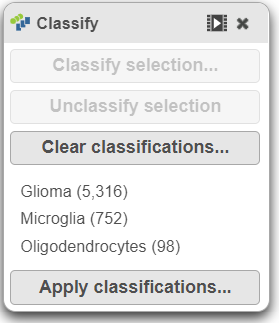 Image Added Image Added
|
- Click Apply classifications in the Classification card on the rightClick the Filtered counts data node as input data for the classification task the Classify icon (Figure 30)
- Click Select
| Numbered figure captions |
|---|
| SubtitleText | choose input data node for multi-sample classification taskApply classifications to the data project |
|---|
| AnchorName | choose input data node for multi-sample classification task |
|---|
| 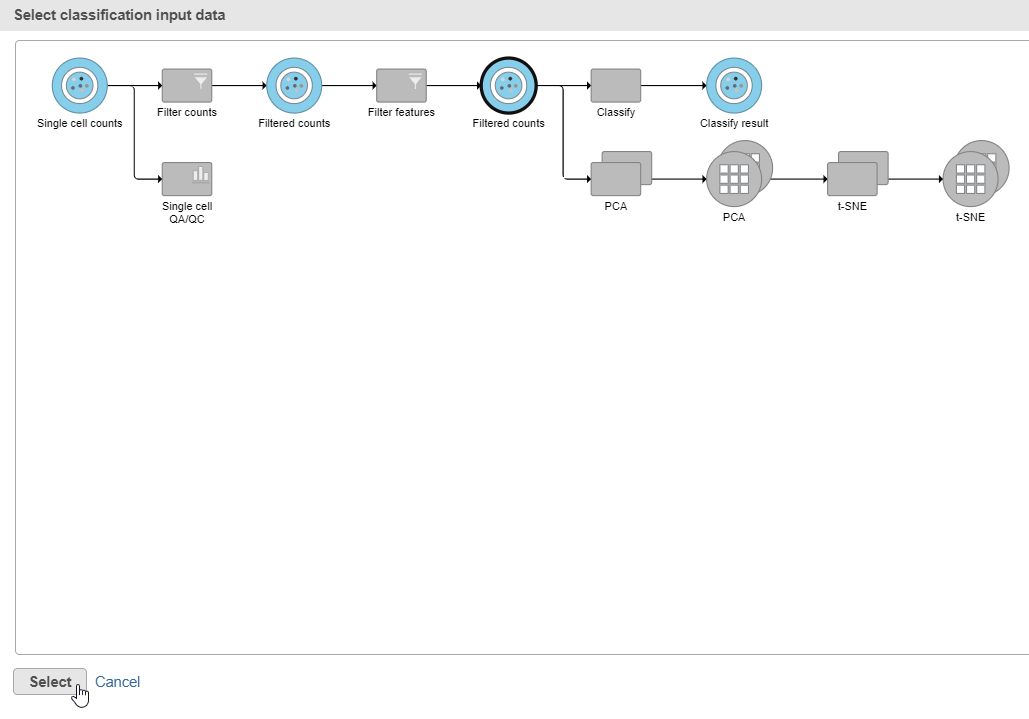 Image Removed
Image Removed| Apply classifications to the data project |
|
 Image Added Image Added
|
- Name the classification attribute Cell type (multi-sample) (Figure 31)
- Click Run
- Click OK on the information box that says a classification task has been enqueued
| Numbered figure captions |
|---|
| SubtitleText | Name the cell-level attribute |
|---|
| AnchorName | Classification attribute name multi-sample |
|---|
|
 Image Removed Image Removed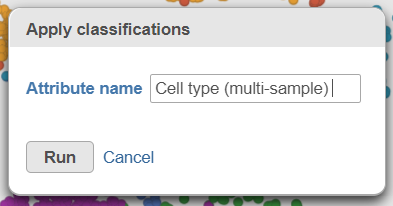 Image Added Image Added
|
A new task, Classify, is added to the Analyses tab. This task produces a new Classify result data node in a green layer (Figure 32).The new attribute is now available for downstream analysis.
- Click on the Glioma (multi-sample) project name at the top to go back to the Analyses tab
- Your browser may warn you that any unsaved changes to the data viewer session will be lost. Ignore this message and proceed to the Analyses tab
| Numbered figure captions |
|---|
| SubtitleText | Classify cells tasks from multi-sample t-SNE plot |
|---|
| AnchorName | Classify cells task |
|---|
|
 Image Removed Image Removed
|
...











































